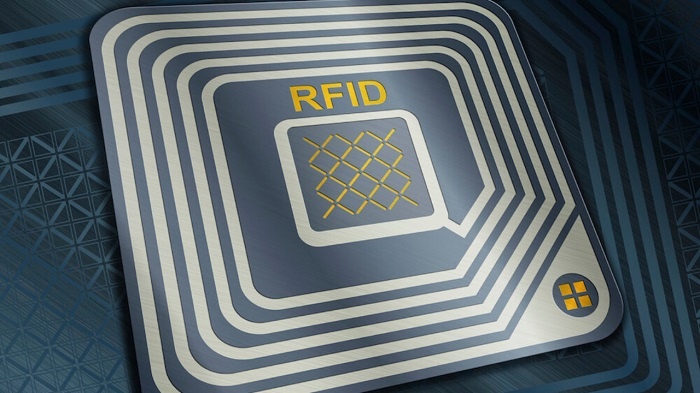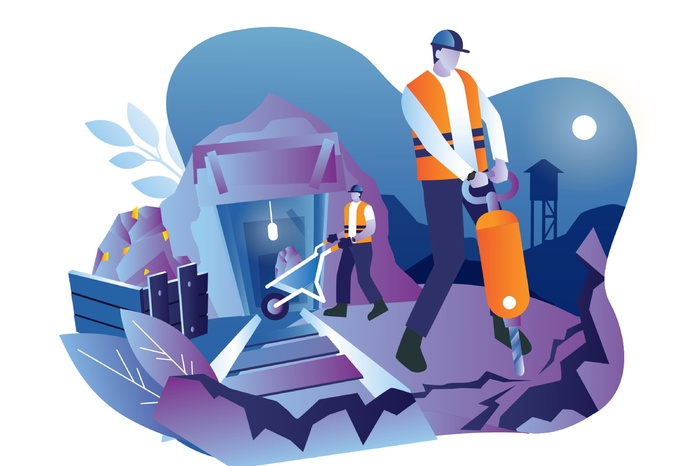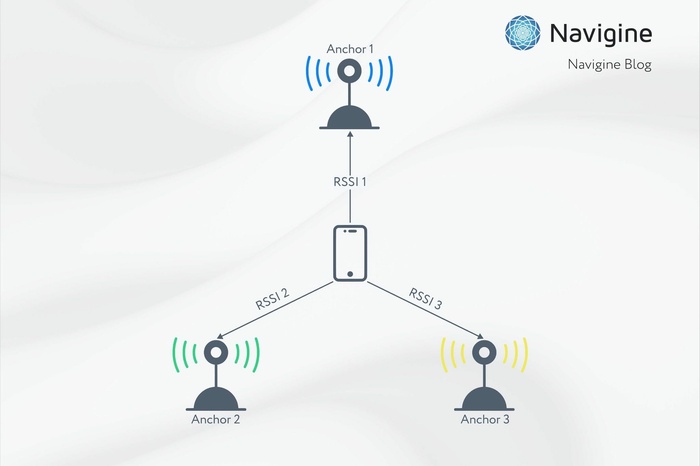Radio-frequency identification technology, or RFID, is a modern positioning system intended for tracking assets or persons. The platform consists of software, readers, and RFID tags (transponders) installed outside or inside the building. RFID location tracking is carried out using radio signals that allow the reader to define and record the data stored in tags.
RFID working principles
A tag is a tiny device consisting of a microchip for storing information and an antenna that directs the received data to a reader. A special shell, placed in a plastic case with fastening elements for attaching to goods or objects, is used for protecting the chip and the antenna against the effects of the external environment.
The reader can be manual or stationary and can work with antennas of any type. The software includes an engine, additional server, and client modules which ensure simple deployment of an RFID location tracking system of any complexity.
To recognize the data, stored in the RFID tag, the reader sends a signal to the transponder. The tag answers the request using radiofrequency emissions where the information, necessary for identification, is encrypted. Then, the reader receives the signal and directs the data to the computer with special software for further processing.
Classification of RFID tags
Tags in the system of radio frequency identification have a wide classification that defines their configuration, assignment, and ways of application.
By source of energy
Based on the source of energy, transponders can be of the following types:
- Passive – devices without their source of energy that transmit information using modulation of the reflected radio signals of the carrier frequency. High-frequency tags have a transmission distance from 1 sm to 2 m, super- and ultra-high frequency transponders – within 1-10 m.
- Active – equipped with a built-in battery; they have a more overall size. The active RFID tag can reproduce outgoing signals of a higher level in comparison with passive transponders and read at a distance of 300 m.
- Semi-passive – tiny microchips with their battery. The range of such devices is defined by the reader’s sensitivity.
By used memory
The transponder can be used for recording or only for reading depending on the type of memory in the microchip:
- Read Only – data is recorded only once at the time of manufacture. During operation, the user can’t add any information to the tag or delete an already existing one. Such transponders are most suitable for identifying goods in shops.
- Write Once Read Many – information is recorded once but can be read many times. Deleting data from the tag is impossible. Such tags are used in warehousing and transport logistics.
- Read and Write – allow multiple recordings and reading. Such tags are used, for example, for monitoring the access to forbidden zones or areas (in the form of access cards, badges, etc.).
By execution
RFID location tracking technology does not restrict manufacturers in the form and execution of transponders. They can be produced in the following forms:
- Stickers – thin stickers, made of paper or plastic, where any information about the goods can be printed.
- Packaged tags - devices in a plastic or glass case that protect the chip against pollution, moisture, or accidental drops.
- Labels, tags – similar to stickers, can be integrated into chipped objects. They are often applied to fabric or the product itself.
- Inlay – have a polyethylene or plastic base; are used for making bank or club cards, passes.
- Special transponders – made for solving certain tasks. For example, they can be used in screws while chipping trees or can be made in the form of bracelets for participants of some events or patients of some medical institutions, thus, employers can use RFID to track people.
RFID application
The modern indoor positioning system using RFID is used in different spheres, including commerce, industry, transport, and logistics.
Industry
Using the technology in the industry ensures management process automation and clear coordination of the staff work. With the help of tags, it’s possible to perform various tasks: tagging materials, commodities, packages, vehicles, equipment. This technology is in great demand, especially in the automobile industry.
Transport
Tracking with RFID is suitable for creating contactless travel cards in public transport. It allows improving the process of getting payments from passengers and reducing expenses of transport companies. Tags are often used for automating toll roads. They can help to protect road users against violations and track vehicles with excessive speed.
Logistics
In logistics, the system helps tracking vehicles and goods. Tags are convenient to use while accepting or loading goods from the warehouse or for inspecting the technical condition of vehicles that deliver goods. Many logistics companies use transponders in sea container traffic. The RFID locator contains the information on the cargo in containers and lets the owner track his goods from one place to another.
Learn more about IoT asset tracking.
Retail
In commerce the usage of RFID positioning solves the following tasks:
- recording revenues and expenditures;
- preventing theft;
- defining forgeries for removing them from the assortment;
- automating warehouse activities;
- gathering statistics for analysis.
The tag is placed on every product and scanned at the checkpoint while selling. The given information is automatically directed to the general database of the shop and the regulatory authorities, which helps to avoid big volumes of additional work.
BLUETOOTH vs RFID
Many effective geolocation solutions aimed at indoor navigation and positioning are available nowadays for modern businesses. The most popular ones are tracking using RFID and BLE technologies. For understanding the distinction between these two technologies, it’s necessary to consider their key criteria – availability, security, and accuracy.
Availability for companies
RFID deployment requires tags, readers, reader management tools, and application software. Consequently, if you are thinking about implementing the program into your operation, in advance you need to plan and invest in the infrastructure - from the side of the sender (tag) and the receiver (reader). Originally, the non-compatibility of the technology with mobile devices requires special hardware to handle signals at certain frequencies.
BLE beacons, operating as signal transmitters, work from batteries and can be adjusted by the mobile application, which makes them portable and scalable. Since beacons can let smartphones perform the function of receivers, it allows considering them a highly available location tracking technology. However, the level of the battery charge of the installed beacons has to be checked regularly.
Accuracy
According to the definition, accuracy (range of operating) is a distance passed by a signal. This indicator depends on many factors: the configuration, power settings, and the environment where the infrastructure is deployed. Thus, in the open-air with fewer obstacles, Bluetooth signals can be of a wider range than inside a building with different surfaces
RFID accuracy can be affected by:
- Frequency – if the frequency is high, it is more sensitive to interference. Metal can reflect radio waves, while water can absorb them at ultra-high frequencies. Consequently, RFID tags are not employed for monitoring metal things or things with high water content.
- Tag antennas – most RFID tags have two antennas for eliminating 'blind spots'. Frequency range optimization of some tags is possible for increasing efficiency.
- Readers and scanning antennas – most RFID systems of the near field are less exposed to interference since they work in a shorter scanning range. RFID systems of the far-field, which can scan from up to some meters, very often encounter problems of a poor connection.
Radio beacons usually have an effective range from 1 to 70 m. But they are also exposed to interference since radio signals are absorbed by various things (metal surfaces, air, water, and human bodies). The working range of the beacon depends on the power of the broadcast signal. The more powerful the signal is, the bigger the range is and, thus, more mobile devices can receive the signal and turn it into data.
Security and confidentiality
As RFID systems are closely connected with typical IP-network solutions, the communication between readers and the network is considered reliable and secure. Radiofrequency communication, appearing between tags and readers, can present the only real threat. In comparison with beacons, which only send a signal with an identifier, RFID sends data connected with the goods (EPC or electronic code). The most common types of data security threats are the following: fraudulent / cloned tags, non-authorized users and data intercept by a non-authorized device.
BLE beacons belong to detection tools that translate outgoing signals, so, while transmitting, there’s no risk for users’ security. But the BLE technology can be dangerous from the perspective of applications that use these signals. Users can face breaking into beacons but most equipment manufacturers have already taken measures to avoid such situations.
Learn more about RFID alternatives.
Navigine specializes in developing and implementing the systems of indoor navigation and positioning inside buildings. In our work we apply location tracking using both RFID and BLE technology, ensuring effective geolocation solutions for efficient business development.




